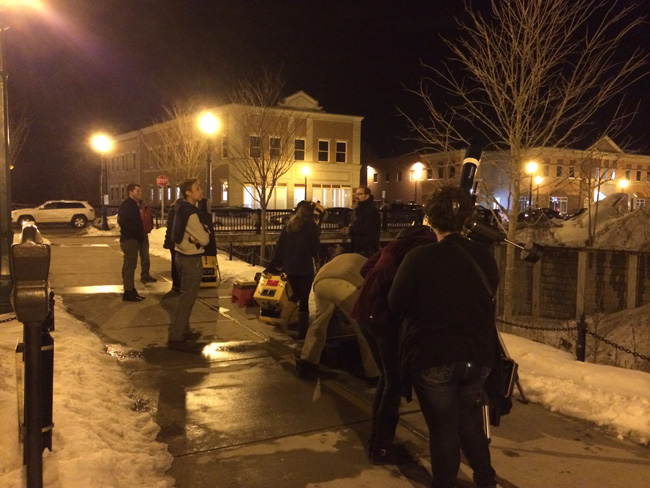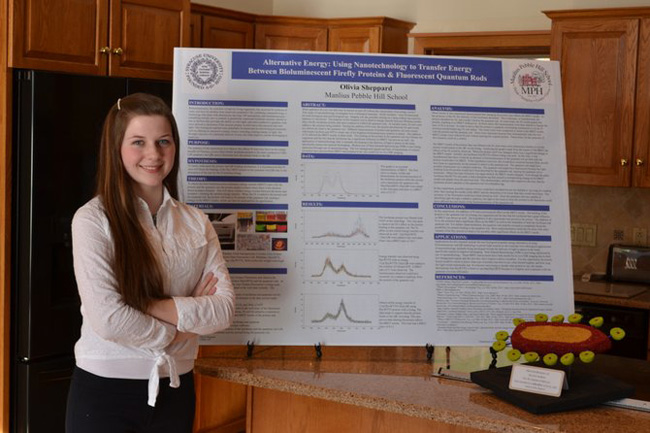Greetings fellow astrophiles!
The next few weeks are busy ones for CNYO and amateur astronomers in general.
– April 10th (just this morning) – STEM Career Day At National Grid (image below)
– April 15th (from midnight to 3:30ish) – Total Lunar Eclipse & Mars Just Past Opposition
– April 12th and 13th – CNYO and New Moon Telescopes (NMT) At NEAF
– April 19th – MOST Climate Day (And CNYO Lecture)
– April 24th – Seasonal Observing At Beaver Lake Nature Center

A piece of Mars, some meteors, several magnets, terrestrial rocks with larger meanings, four things we didn’t know “when I was their age,” and additional makings of a set of STEM astro demos.
But back to the eclipse and opposition. It is my opinion that lunar eclipses don’t get the respect they deserve. Yes, solar eclipses are much more exciting and it has been well-documented that people have previously responded very strongly (and not always pleasantly) to solar eclipses. The sudden darkening of the sky and noticeable temperature drop can cause all shades of responses (no pun intended) in people. That said, all we really get (besides a view of the solar corona) is an example of what happens when you put a black disc in front of the Sun. Lunar eclipses, on the other hand, tell us a bit about how the Earth itself interacts with the Sun by how this interaction alters our view of the Moon.
Both solar and lunar eclipses tell us something about the Sun/Earth/Moon relationship. Specifically, we learn that the Sun/Earth orbital plane (the oval made as the Earth goes around the Sun each year) and the Earth/Moon orbital plane (our local oval) are not the same – the Earth/Moon plane is tilted slightly off the Sun/Earth plane by 5.2 degrees (small, but just enough). That is, the Moon spends some time above and some times below the Sun/Earth orbital plane, while sitting right in the plane only two times each orbit (where the two planes intersect). How do we know this? Simple. If the Earth/Moon plane were exactly in the Sun/Earth plane, there would be a total solar eclipse and total lunar eclipse every month because there would be a time each month (New Moon) when the Sun, Moon, and Earth made a straight line (Sun-Moon-Earth = solar eclipse) and a time each month (Full Moon) when the Sun, Earth, and Moon made a straight line (Sun-Earth-Moon = lunar eclipse). As the two planes are slightly off, the New Moon is simply “off the radar” of most people because it can’t be seen during the daytime. The Full Moon, on the other hand, is brilliantly bright most of the time because it only infrequently enters the Earth’s shadow.
The image below shows this very nicely (and it’s always better to find and cite a good image than to have to roll your own). Give it a look for 30 seconds to make sure each of the four cases make sense to you.

The Sun/Earth and Earth/Moon orbital planes. Note the top and bottom orientations that are perfect for eclipses (and the left and right that are not). Image taken from www2.astro.psu.edu (from Chaisson & McMillan Publishing). Click for a larger view.
Total solar and lunar eclipses, then, occur on special, but periodic and predictable, occasions when the Moon finds itself exactly in the Sun/Earth plane. When it’s just ever-so-slightly off this plane AND still between the Sun and Earth (or still falls into the Earth’s shadow in the Sun-Earth-Moon arrangement), we get partial eclipses. Just that simple.

What to expect on April 15th (the government’s cashing in on its short wavelength tax!). Image from this article at io9.com.
Perhaps the most striking difference between a solar and lunar eclipse is that a solar eclipse obstructs the disc of the Sun, leaving only a view of its wispy exterior (corona), while a lunar eclipse alters the color of the Moon while still allowing us to see it in its entirety. Those watching the lunar eclipse will see the Moon go from its usual bright grey to orange, then a dark red before reversing the color order. The reason for this dark red coloring is the same reason why our sky is blue – the scattering of light in our atmosphere. Recalling our handy scattering relationship – that scattering (I) is proportional to 1 / wavelength4, we see that shorter wavelengths scatter more than longer wavelengths (because the wavelengths are in the bottom of the proportion, so larger numbers decrease the value of “I”). The image below was taken from one of the great non-wikipedia physics sites (well worth several afternoons to explore), hyperphysics.phy-astr.gsu.edu.
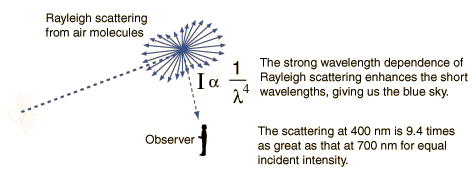
We see that shorter wavelength light gets “bounced around” more, while longer wavelength light passes for longer distances unimpeded by interactions with molecules and larger particles (like soot after big volcanic eruptions) in our atmosphere. Light going straight from the Sun hits our atmosphere and gets increasingly scattered as wavelength gets shorter – blue scatters more than red, so we see the blue strongly when we look up during the day. With the blue light strongly scattered, those people on the edges of where the Sun’s light falls – those just starting or ending their days – see more red light because that wavelength wasn’t as strongly scattered – effectively those at sunrise and sunset get the filtered-out leftovers of the light that those at high noon see as blue. The “lit” side of the world experiences a range of different colors depending on where they are during the day, but all are being illuminated by waves of light from the Sun that left at the same exact time (plus or minus a nanosecond or two).
Because it’s a busy week and the author is feeling lazy, he refers you to the top image of the three-panel image below, showing how the scattering of sunlight in our atmosphere occurs sooner after entry (on average) for blue, a bit later (on average) for green, then a bit later (on average) for yellow, then out to red, some of which is and isn’t scattered (on average).
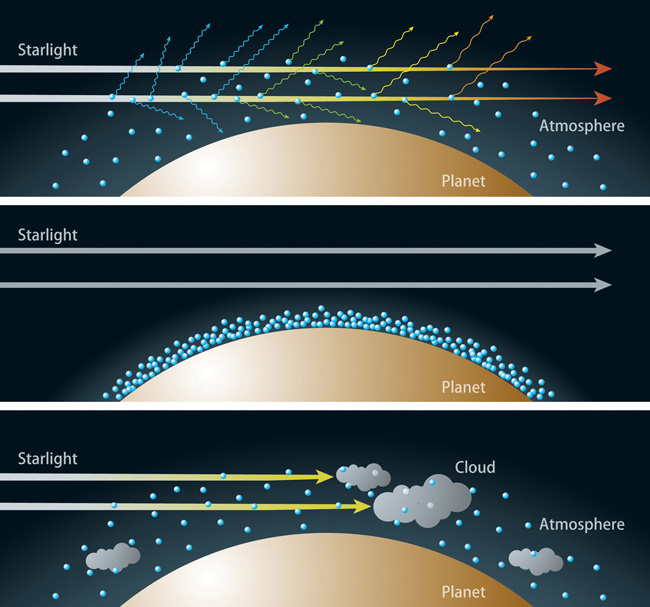
The scattering of light by Earth’s atmosphere (shorter wavelengths scatter sooner). The other two images are placed into context by your reading about extrasolar planetary atmosphere studies. See www.universetoday.com/…-in-blue-light/ for that info.
And so, we know that blue is scattered strongly and red is not. This red light then races to the edges of our illuminated globe and the red light not scattered directly down to Earth or scattered in the opposite direction (out into space right above you) races past Earth at various altered (scattered) angles. During the most complete part of the lunar eclipse, the red color you see is, in fact, the red light that is passing through the edges of our atmosphere at those places experiencing sunrise and sunset (the sunlight performing a “grazing blow” of our atmosphere). As you might guess, if Earth were to lose its atmosphere (but don’t give any of your industrious friends any ideas), our lunar eclipses would appear quite different. Instead of a dark red Moon, we’d simply see a black disc where no stars shone (like placing a quarter at arms length and obscuring anything behind it).
This lunar eclipse just happens to coincide with another special event in our Solar System that just passed on April 8th – Mars at Opposition. Earth-centric oppositions occur when the Sun and a planet (from Mars out to Neptune, then dwarf planets, comets and asteroids also fit the description) are on opposite sides of the sky to one another (this cannot happen for Venus and Mercury to an observer standing on Earth – this also means that Earth is never “at opposition” for Mars). This necessarily means that, when this occurs, the Earth and that other object are as close as they will get for that Earth year. Because our orbits are not circular around the Sun, our distances at opposition do vary. The slightly outdated image below shows this difference of opposition distances for Mars from 1995 to 2001. August of 2003 was our closest approach (34 million miles) to Mars in roughly 60,000 years, making for some impressive views through even medium-sized scopes.
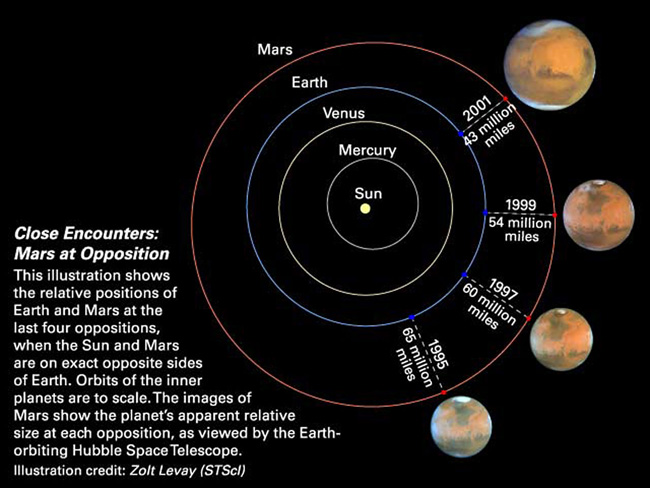
Mars distances at four oppositions. Image taken from the Hubble Space Telescope website. Click for a larger view.
What does this opposition mean for us? For those attending Baltimore Woods for Bob Piekiel’s special Lunar Eclipse observing session on the (really early) morning of April 15th (that is, we’ll be set up from 11:00 p.m. on the 14th and hanging out until it’s over), this means that Mars will be just a few days past its closest approach to Earth, making for especially good views through the scopes in attendance. Add Jupiter and Saturn over the course of the lunar eclipse, and we’ve a small feast of planetary observation for the evening. We hope you can join us!
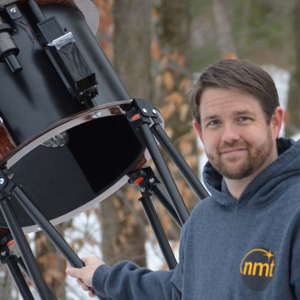 Ryan E. Goodson became fascinated with astronomy after seeing a meteor-turned-fireball streak across a wheat field in Wichita, Kansas in April of 2005. This led to an early involvement in amateur astronomy that quickly turned into an obsession. Since that time he has spent countless hours studying telescope design, structural engineering, and optics in order to perfect what has become the large and small truss-style telescopes he manufactures today as the owner of New Moon Telescopes in West Monroe, NY.
Ryan E. Goodson became fascinated with astronomy after seeing a meteor-turned-fireball streak across a wheat field in Wichita, Kansas in April of 2005. This led to an early involvement in amateur astronomy that quickly turned into an obsession. Since that time he has spent countless hours studying telescope design, structural engineering, and optics in order to perfect what has become the large and small truss-style telescopes he manufactures today as the owner of New Moon Telescopes in West Monroe, NY.






